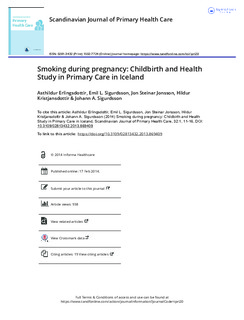| dc.contributor.author | Erlingsdottir, Asthildur | |
| dc.contributor.author | Sigurdsson, Emil Larus | |
| dc.contributor.author | Jonsson, Jon Steinar | |
| dc.contributor.author | Kristjansdottir, Hildur | |
| dc.contributor.author | Sigurdsson, Johann Agust | |
| dc.date.accessioned | 2019-10-29T08:48:24Z | |
| dc.date.available | 2019-10-29T08:48:24Z | |
| dc.date.created | 2014-01-12T08:04:28Z | |
| dc.date.issued | 2014 | |
| dc.identifier.citation | Scandinavian Journal of Primary Health Care. 2014, 32 (1), 11-16. | nb_NO |
| dc.identifier.issn | 0281-3432 | |
| dc.identifier.uri | http://hdl.handle.net/11250/2625029 | |
| dc.description.abstract | Objective. To study the prevalence and possible predictors for smoking during pregnancy in Iceland. Design. A cross-sectional study. Setting. Twenty-six primary health care centres in Iceland 2009–2010. Subjects. Women attending antenatal care in the 11th–16th week of pregnancy were invited to participate by convenient consecutive manner, stratified according to residency. A total of 1111 women provided data in this first phase of the cohort study. Main outcome measures. Smoking habits before and during early pregnancy were assessed with a postal questionnaire, which also included questions about socio-demographic background, physical and emotional well-being, and use of medications. Results. The prevalence of smoking prior to pregnancy was 20% (223/1111). During early pregnancy, it was 5% (53/1111). In comparison with women who stopped smoking during early pregnancy, those who continued to smoke had on average a significantly lower level of education, had smoked more cigarettes per day before pregnancy, and were more likely to use nicotine replacement therapy in addition to smoking during pregnancy. A higher number of cigarettes consumed per day before pregnancy and a lower level of education were the strongest predictors for continued smoking during pregnancy. Conclusion. The majority of Icelandic women who smoke stop when they become pregnant, and the prevalence of smoking during pregnancy in Iceland is still about 5%. Our results indicate stronger nicotine dependence in women who do not stop smoking during pregnancy. Awareness of this can help general practitioners (GPs) and others providing antenatal care to approach these women with more insight and empathy, which might theoretically help them to quit. | nb_NO |
| dc.language.iso | eng | nb_NO |
| dc.publisher | Taylor & Francis | nb_NO |
| dc.rights | Navngivelse 4.0 Internasjonal | * |
| dc.rights.uri | http://creativecommons.org/licenses/by/4.0/deed.no | * |
| dc.title | Smoking during pregnancy. Childbirth and Health Study in Primary Care in Iceland | nb_NO |
| dc.type | Journal article | nb_NO |
| dc.type | Peer reviewed | nb_NO |
| dc.description.version | publishedVersion | nb_NO |
| dc.source.pagenumber | 11-16 | nb_NO |
| dc.source.volume | 32 | nb_NO |
| dc.source.journal | Scandinavian Journal of Primary Health Care | nb_NO |
| dc.source.issue | 1 | nb_NO |
| dc.identifier.doi | 10.3109/02813432.2013.869409 | |
| dc.identifier.cristin | 1088139 | |
| dc.description.localcode | © 2014 Informa Healthcare This is an Open Access article distributed under the terms of the Creative Commons Attribution License (http://creativecommons.org/licenses/by/3.0), which permits unrestricted use, distribution, and reproduction in any medium, provided the original work is properly cited. The moral rights of the named author(s) have been asserted. | nb_NO |
| cristin.unitcode | 194,65,20,0 | |
| cristin.unitname | Institutt for samfunnsmedisin og sykepleie | |
| cristin.ispublished | true | |
| cristin.fulltext | original | |
| cristin.qualitycode | 1 | |

